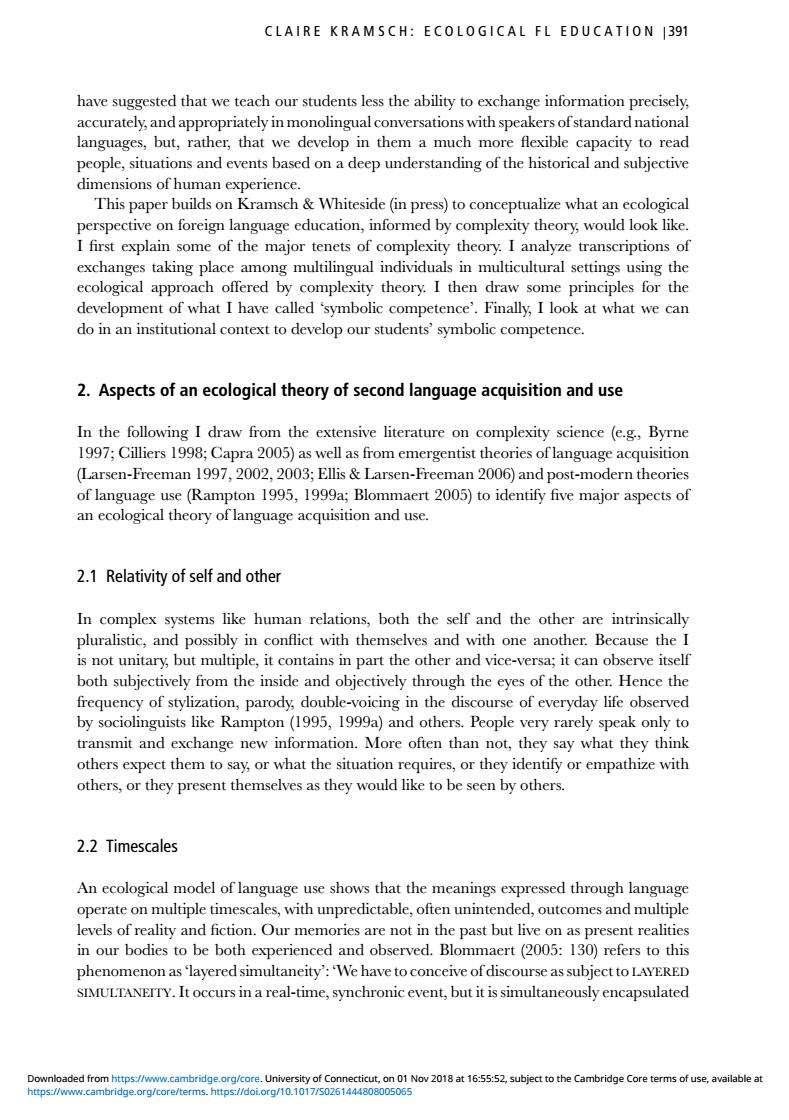正在加载图片...

CLAIRE KRAMSCH:ECOLOGICAL FL EDUCATION 391 have suggested that we teach our students less the ability to exchange information precisely accurately,and appropriately in monolingual conversations with speakers ofstandard national languages,but,rather,that we develop in them a much more flexible capacity to read people,situations and events based on a deep understanding of the historical and subjective dimensions of human experience. ppt加don Kran山&ee prt coe ess)to con eptualize what an ecological on foreign language education,inform ity theory,would look like I first explain some of the major tenets of complexity theory.I analyze transcriptions of exchanges taking place among multilingual individuals in multicultural settings using the ecological approach offered by complexity theory.I then draw some principles for the development of what I have called'symbolic competence'.Finally,I look at what we can do in an institutional context to develop our students' 2.Aspects of an ecological theory of second language acquisition and use In the following I draw from the extensive literature on complexity science (e.g,Byrne 2005)as well as from en ries of languag ,2003 Ellis&Larsen-Freeman 2006)and post-modern theories of language use(Rampton 1995,1999a;Blommaert 2005)to identify five major aspects of an ecological theory of language acquisition and use. 2.1 Relativity of self and other In complex systems like human relations,both the self and the other are intrinsically pluralistic,and possibly in conflict with themselves and with one another.Because the I is not unitary,but multiple,it contains in part the other and vice-versa;it can observe itself both subjectively from the inside and objectively through the eyes of the other.Hence the n,parody, ing in the dis Bampon (1995.1999a)nd other Pople vry rarely eak on to our e of everyday life observed transmit and exchange new information.More often than not,they say what they think others expect them to say,or what the situation requires,or they identify or empathize with others,or they present themselves as they would like to be seen by others. 2.2 Timescales An ecological model of language use shows that the meanings expressed through language operateon mwith unpredictable,ofen unintended,outcomes and mulpl not in past buti s present real in our bodies to be both and observed.Blomm aert(2005:130)refers to thi phenomenon as'lavered simultaneity:'We have to conceive of discourse as subject to LAYERED SIMULTANEITY.It occurs in a real-time,synchronic event,but it is simultaneously encapsulated CLAIRE KRAMSCH: ECOLOGICAL FL EDUCATION 391 have suggested that we teach our students less the ability to exchange information precisely, accurately, and appropriately in monolingual conversations with speakers of standard national languages, but, rather, that we develop in them a much more flexible capacity to read people, situations and events based on a deep understanding of the historical and subjective dimensions of human experience. This paper builds on Kramsch & Whiteside (in press) to conceptualize what an ecological perspective on foreign language education, informed by complexity theory, would look like. I first explain some of the major tenets of complexity theory. I analyze transcriptions of exchanges taking place among multilingual individuals in multicultural settings using the ecological approach offered by complexity theory. I then draw some principles for the development of what I have called ‘symbolic competence’. Finally, I look at what we can do in an institutional context to develop our students’ symbolic competence. 2. Aspects of an ecological theory of second language acquisition and use In the following I draw from the extensive literature on complexity science (e.g., Byrne 1997; Cilliers 1998; Capra 2005) as well as from emergentist theories of language acquisition (Larsen-Freeman 1997, 2002, 2003; Ellis & Larsen-Freeman 2006) and post-modern theories of language use (Rampton 1995, 1999a; Blommaert 2005) to identify five major aspects of an ecological theory of language acquisition and use. 2.1 Relativity of self and other In complex systems like human relations, both the self and the other are intrinsically pluralistic, and possibly in conflict with themselves and with one another. Because the I is not unitary, but multiple, it contains in part the other and vice-versa; it can observe itself both subjectively from the inside and objectively through the eyes of the other. Hence the frequency of stylization, parody, double-voicing in the discourse of everyday life observed by sociolinguists like Rampton (1995, 1999a) and others. People very rarely speak only to transmit and exchange new information. More often than not, they say what they think others expect them to say, or what the situation requires, or they identify or empathize with others, or they present themselves as they would like to be seen by others. 2.2 Timescales An ecological model of language use shows that the meanings expressed through language operate on multiple timescales, with unpredictable, often unintended, outcomes and multiple levels of reality and fiction. Our memories are not in the past but live on as present realities in our bodies to be both experienced and observed. Blommaert (2005: 130) refers to this phenomenon as ‘layered simultaneity’: ‘We have to conceive of discourse as subject to LAYERED SIMULTANEITY. It occurs in a real-time, synchronic event, but it is simultaneously encapsulated https://www.cambridge.org/core/terms. https://doi.org/10.1017/S0261444808005065 Downloaded from https://www.cambridge.org/core. University of Connecticut, on 01 Nov 2018 at 16:55:52, subject to the Cambridge Core terms of use, available at